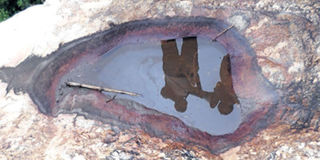For those with religious bent, Kalamba’s worth a pilgrimage

A depression on Nzaui rock in Kalamba village, Makueni County. African Inland missionaries set up their first church here in 1895. PHOTO | PIUS MAUNDU | NATION MEDIA GROUP
What you need to know:
- Tucked in Nzaui location, the shopping centre, where the very first African Inland Church stands stoic today, owes its existence to the work of European missionaries who traversed the countryside.
- When I visited Kalamba two weeks ago, the spectacular scene at the centre of rolling hills covered in tiny farm houses and patches of maize and mango trees hid the church which the missionaries established 120 years ago.
- Curious scholars studying how the Christian mission that birthed the African Inland Church chose to settle at this place return fascinating accounts.
Kalamba shopping centre in Makueni County is among the most notable places in the region.
It is here that African Inland Mission evangelists, whose humble beginnings in Kalamba village in the 19th Century, would over the years multiply 1000-fold to over 3,000 churches, spread in the region and beyond.
Tucked in Nzaui location, the shopping centre, where the very first African Inland Church stands stoic today, owes its existence to the work of European missionaries who traversed the countryside.
When I visited Kalamba two weeks ago, the spectacular scene at the centre of rolling hills covered in tiny farm houses and patches of maize and mango trees hid the church which the missionaries established 120 years ago.
And tucked 300 metres behind the patchwork of scattered tin and mud shops, and stalls laden with sukuma wiki and coloured fruits is the humble relic.
The vista meeting the eye is reminiscent of the era: baked mud bricks, tin roofed, built on a boulder with no windows or doors but arches in its two entrances.
Curious scholars studying how the Christian mission that birthed the African Inland Church chose to settle at this place return fascinating accounts.
An essay by Mr Watson Omulokoli published in 1995 in the African Journal of Evangelical Theology, the man behind the mission, Mr Peter Cameroon Scott, sailed from Scotland and upon landing in Mombasa in 1895 and, trekked for two weeks into the countryside, with other missionaries in tow.
And this remote location that Mr Scott would start his mission became Kalamba village on the leeward side of Nzaui hills, a must-have element in the Kamba mythology on their existence.
Legend has it that the first Kamba family descended from heaven and landed on this boulder, a theory that is accentuated by impressions of human footprints on a rock on the hill overlooking the site of the church.
Unfortunately, Mr Scott did not live long to see the seed he had planted germinate and sprout.
According to folklore, Mr Scott died in 1896 when Syumbesa, a local witch who was opposed to his work, sent a swarm of bees that attacked him.
However, Mr Stanley Kitati, the pastor in charge of the the Kalamba church, rubbishes the claims.





